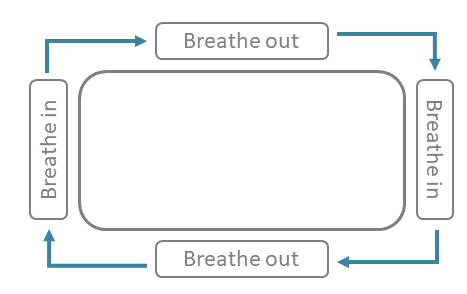Emergency control techniques
The following techniques aim to open the vocal cords so you can breathe more easily at the level of the throat. This video gives a brief explanation of things to remember when carrying out these exercises.
These exercises can be helpful if you are experiencing:
- The urge to cough
- A cough, or throat clearing
- A tightness in your throat that makes it difficult to breathe
These exercises can help to:
Prevent symptoms from happening: Try to identify triggers and ‘early warning signs’ of throat symptoms e.g., a tickle in your throat, so you can try the techniques before symptoms start.
Make symptoms less severe/ shorter: If your symptoms have already started, these exercises can help to make the episode less severe, and/or make the symptoms stop earlier.
This page is also available as a document here.
Your SLT will give more specific guidance on techniques and advise which is most helpful for you. The most commonly used techniques are:
SNIFF EXERCISES
Sniff puff puff
- Take a sharp sniff in through your nose.
- Gently blow the air out through pursed lips, on two puffs. Try to puff up (inflate) your cheeks if you can.Aim for the second puff to be longer.
- If you can’t ‘puff’ your cheeks, you can just breathe out through pursed lips – pff sound.
Sniff and blow
- Take a sharp sniff in through your nose.
- Gently blow the air out through pursed lips on one longer breath. Try to puff up (inflate) your cheeks if you can. Aim to breathe out for 2-3 seconds.
- If you can’t ‘puff’ your cheeks, you can just breathe out through pursed lips
Sniff and voice
- Take a sharp sniff in through your nose
- Blow the air out on one gentle breath making a ‘dge’ or ‘zz’ sound. Aim to breathe out for 2-3 seconds
PURSED LIPS (SUCK) EXERCISES
Suck puff puff
- Purse your lips and take a short sharp breath in (like sucking up spaghetti).
- Gently blow the air out on two puffs through pursed lips, try to puff up (inflate) your cheeks if you can.Aim for the second puff to be longer.
- If you can’t ‘puff’ your cheeks, you can just breathe out through pursed lips – pff sound.
Suck and blow
- Purse your lips and take a short sharp breath in (like sucking up spaghetti).
- Gently blow the air out through pursed lips on one longer breath. Try to puff up (inflate) your cheeks if you can.Aim to breathe out for 2-3 3 seconds.
- If you can’t ‘puff’ your cheeks, you can just breathe out through pursed lips - – pff sound.
Suck and voice
- Purse your lips and take a short sharp breath in (like sucking up spaghetti)
- Gently blow out making ‘dge’ sound (like at the end of the word Fridge) or a zz
STRAW EXERCISES
Suck puff puff with straw
- Seal your lips around the straw and take a short sharp breath in
- Blow the air out on two puffs through the straw, try to inflate your cheeks if you can. Aim for the second puff to be longer
Suck and puff (blow) with straw
- Seal your lips around the straw and take a short sharp breath in
- Blow the air out on one gentle breath through the straw, try to inflate your cheeks if you can. Aim to breathe out for 2-3 seconds.
Suck and voice with straw
- Seal your lips around the straw and take a short sharp breath in
- Blow the air out on one gentle breath through the straw making a ‘oo’ sound (this might sound like a ‘dge’, try to inflate your cheeks if you can). Aim to breathe out for 2-3 seconds.
ILO
During an ILO attack, the vocal cords come together (usually on the inhale) making it difficult to get air past the throat, into the airway
Cough
During a coughing attack, the vocal cords slam together aggressively, this can irritate the vocal cords and lining of the throat. It can also result in more throat tension
Sniff – puff puff
During a sniff puff-puff forces the vocal cords open, making it easier to breathe, and easier to stop the cough.
Yes. We recommend practicing exercises ‘little and often’ each day, even when you are not experiencing symptoms. This will help re-train the muscle memory so the exercises can be done more easily when you need them (making them feel more automatic).
Different people have different exercise needs, but one example is to practice:
- 3 sets, 5 times a day
Example:
- Set 1: Sniff puff puff - Sniff puff puff - Sniff puff puff
REST FOR 5- 10 seconds - Set 2: Sniff puff puff - Sniff puff puff - Sniff puff puff
REST FOR 5 -10 seconds
- Set 3: Sniff puff puff – Sniff puff puff – Sniff puff puff
Your SLT will give you more specific guidance in your appointment.
- These exercises help to improve breathing at the level of your throat, by opening the entrance to your airway.
- Coughing and gasping for air could make your symptoms worse, especially if your mouth is wide open (often shooting dry air and/or irritants to the back of the throat)
- When we panic, muscles often tighten up, breaths tend to be shallower and faster, and the lining of our mouth and throat can become drier.
- If you have had a nasendoscopy, try to remember seeing your larynx opening during the exercises to improve airflow.
- Don’t hold your breath to try and stop a cough.
- Swap a ‘throat clear’ for a swallow (to clear any mucus) and nasal breathing to divert irritation away from the throat.
- Breathe in through your nose or pursed lips where possible. This helps to filter, warm, and slow down the air flow, making it less irritating in the throat.
- Focus on the breath out, more than the breath in. Try ‘rectangle breathing’.

- Try to use diaphragmatic breathing, keeping your shoulders relaxed.
- Do your emergency technique for as long as you need to (one that suits you from the examples).
- If your throat feels tight, try a yawn or other ‘deconstriction technique’.
Rather than doing a sniff, breathe in through pursed lips as if sucking up spaghetti or breathing in through a straw.
Consider steam inhalation or using a nasal rinse to clear a blocked nose. If you have persistent nasal symptoms, contact your GP, respiratory consultant, or ear, nose and throat (ENT) doctor.
You may be given some other exercises to support your breathing, throat relaxation and/or voice. Further information can be found here:
